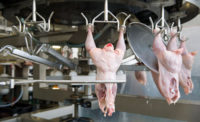With employees in Nebraska’s meat processing industry at higher risk for injury while on the job, OSHA has launched a local emphasis program focused on safety.
The program will concentrate on educating employers on hazards common to the meat processing industry such as musculoskeletal and repetitive motion injuries, machine guarding, control of hazardous energy and process safety management. Bureau of Labor Statistics’ data indicates that 7.5 percent of meat processing workers experienced recordable injuries or illness in 2014.
“The local emphasis program on the meat processing industry provides outreach and education to assist employers to eliminate hazardous working conditions,” says Jeff Funke, OSHA area director in Omaha. “Workplace injuries, illnesses and deaths are always preventable when employers implement a safety and health program focused on hazard identification, corrective actions and employee training.”
Musculoskeletal disorders are among the most preventable injuries in the meat processing industry. Employees can suffer cumulative trauma injuries in their joints, ligaments, muscles, nerves, tendons and structures resulting from repetitive actions and motions. OSHA is focused on reducing the negative effects of these degenerative diseases and will be evaluating ergonomic stressors as part of the local emphasis program.
OSHA’s regional and/or area offices implement regional and local emphasis programs as strategic enforcement efforts to reduce injuries in address high-risk industries. Each program begins with a three-month period of education and prevention outreach activities to share safety and health information with employers, associations and workers. OSHA encourages employers to use this period to bring their facilities into compliance with federal safety and health standards, if they are not already.
The emphasis program ends Sept. 30, 2016, unless extended.






